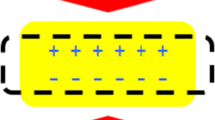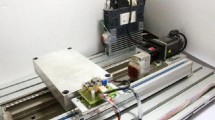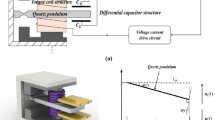Abstract
This paper describes how piezoelectric accelerometers can be applied to motion control systems for performance enhancements. Piezoelectric accelerometers are known for their wide frequency ranges to sense dynamic acceleration. However, they are unable to measure static and quasi-static acceleration. Since positional sensors generally exist in motion control systems, this paper presents two acceleration observers that fuse piezoelectric accelerometers and positional sensors and are able to achieve high-quality observation of acceleration, including static and quasi-static components. The proposed observers are applied to a robotic manipulator, and experimental results confirm feasibility and effectiveness of the proposed acceleration observers.

















Similar content being viewed by others
References
de Jager B (1994) Acceleration assisted tracking control. IEEE Control Syst Mag 14:20–27
Deng C, Tang T, Mao Y, Ren G (2017) Enhanced disturbance observer based on acceleration measurement for fast steering mirror systems. IEEE Photonics J 9:1–11
Plummer AR (2016) Model-based motion control for multi-axis servohydraulic shaking tables. Control Eng Practice 53:109–122
Nashawati N, Albitar C, Dib A (2019) The evaluation of two methods for active vibration damping using RUS Hexapod platform. Trans Inst Meas Control 41(5):1207–1215
Tan KK, Lim SY, Lee TH, Dou H (2000) High-precision control of linear actuators incorporating acceleration sensing. Robot Comput-Integr Manuf 16:295–305
Dumetz E, Dieulot JY, Barre PJ, Colas F, Delplace T (2006) Control of an industrial robot using acceleration feedback. J Intell Robot Syst 46(2):111–128
Youcef-Toumi K, Ito O (1990) A time delay controller for systems with unknown dynamics. ASME J Dyn Sys Meas Control 112:133–142
Lu YS, Lee CH (2017) Experimental evaluation of acceleration-enhanced velocity estimation algorithms using a linear motion stage. J Braz Soc Mech Sci Eng 39:543–551
Thenozhi S, Yu W, Garrido R (2013) A novel numerical integrator for velocity and position estimation. Trans Inst Meas Control 35(6):824–833
Zheng J, Fu M (2010) A reset state estimator using an accelerometer for enhanced motion control with sensor quantization. IEEE Trans Control Syst Technol 18:79–90
Xu L, Fang L, Lin C, Guo D, Qi Z, Huo R (2019) Design of distance measuring system based on MEMS accelerometer. J Electr Eng Technol. https://doi.org/10.1007/s42835-019-00171-4
Xu F, Yang Z, Hu J, Jiang G, Dai G (2018) Fault diagnosis of a selective compliance assembly robot arm manipulator based on the end joint motion analysis: Threshold algorithm and experiments. Trans Inst Meas Control 40(5):1691–1700
Jeong JW, Chang PH, Park KB (2011) Sensorless and modeless estimation of external force using time delay estimation application to impedance control. J Mech Sci Technol 25:2051–2059
Han JD, He YQ, Xu WL (2007) Angular acceleration estimation and feedback control: An experimental investigation. Mechatronics 17:524–532
Evren Han S, Unel M (2019) An acceleration-based hybrid learning-adaptive controller for robot manipulators. Trans Inst Meas Control 41(8):2114–2123
Lu YS, Wang HW, Liu SH (2018) An integrated accelerometer for dynamic motion systems. Measurement 125:471–475
Liu J, Luo X, Liu J, Li M, Qin L (2017) Development of a commercially viable piezoelectric force sensor system for static force measurement. Meas Sci Technol 28:1–7
Katsura S, Irie K, Ohishi K (2008) Wideband force control by position acceleration integrated disturbance observer. IEEE Trans Ind Electron 55:1699–1706
Lu YS, Lin YY (2018) Smooth motion control of rigid robotic manipulators with constraints on high-order kinematic variables. Mechatronics 49:11–25
Abdelhameed MM (2005) Enhancement of sliding mode controller by fuzzy logic with application to robotic manipulators. Mechatronics 15:439–458
Acknowledgements
The authors are grateful to the Ministry of Science and Technology of Taiwan for supporting this research under Grant MOST 109-2221-E-003-022.
Author information
Authors and Affiliations
Corresponding author
Additional information
Publisher's Note
Springer Nature remains neutral with regard to jurisdictional claims in published maps and institutional affiliations.
Rights and permissions
About this article
Cite this article
Lu, YS., Lu, CW. Low-Frequency Compensation of Piezoelectric Accelerometers for Motion Control Systems. J. Electr. Eng. Technol. 16, 2221–2234 (2021). https://doi.org/10.1007/s42835-021-00735-3
Received:
Revised:
Accepted:
Published:
Issue Date:
DOI: https://doi.org/10.1007/s42835-021-00735-3




